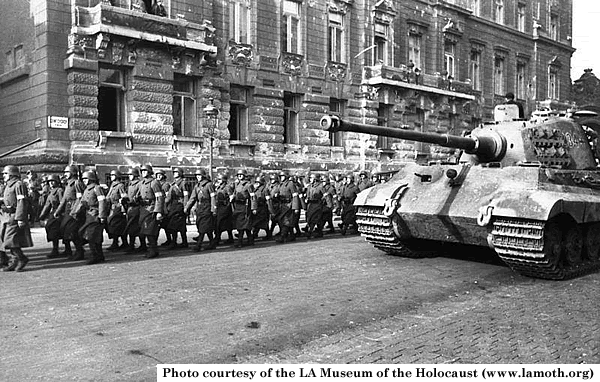“March 19, 1944. I never forget that day,” my grandmother told me. She spoke in that particular Hungarian accent, with its often-compressed phrases and odd-sounding emphasis on early syllables. “NEVerforget” began with an exclamation and a shake of the head.
Game up
On that date, the German army occupied its ally Hungary, at the invitation of Hungary’s leaders. On that date the game was up. Hungary had been divided between more rabid anti-Semites and a ruling class of noblemen whose anti-Semitism (particularly for countryside, lower-class Jews, as opposed to the wealthy Jewish landowners or industrialists they knew personally) was counterbalanced by a quaint if inconsistent sense of honor. Humiliated by the hated Trianon treaty after World War I, under which Hungary lost two-thirds of its territory, as World War II dawned, Hungary dreamed of regaining past glory (or at least lands). It allied itself with Germany, and doubled its territory with spoils from German victories as rewards for major anti-Jewish laws passed between 1938 and 1941.
Germany pressed for more, for deportation. Yet the Hungarians put off such action, offering up further discriminatory measures. Wrote Joseph Goebbels in his diary in the spring of 1943, “The Jewish question is being solved least satisfactorily by the Hungarians.” His point is illustrated by the fact that as Goebbels wrote my Jewish grandfather was still running his fabric store in Budapest. My grandfather died on April 9th of that year of natural causes. (A cousin had stopped by the store and to share a joke. My grandfather was smoking a cigarette and laughing at the joke when he was struck by a fatal brain hemorrhage.)
‘We have allied ourselves with scoundrels’
In late April 1943, Hungary’s leader, Admiral Miklos Horthy (“We used to have a navy!” my grandmother would declare proudly) met with Hitler and demurred again in the face of Hitler’s demand for the Jews. By early 1944 the Hungarians were looking for a way out and sent peace feelers to the western powers. Worried about the commitment of its ally and the security of Hungary’s oil reserves, angered by the peace feelers and Hungary’s relative inaction on the Jews, Hitler demanded, and Horthy agreed to, occupation by Germany.
Many Hungarian leaders felt as Pal Taleki, the prime minister who committed suicide in 1941 after the invasion of Yugoslavia. His suicide note read in part: “We have become breakers of our word…. I have allowed the nation’s honor to be lost. The Yugoslav nation are our friends…. But now, out of cowardice, we have allied ourselves with scoundrels.”
And yet, many, including ordinary Hungarian citizens, welcomed the occupation. “A day in Yugoslavia was more dangerous than a year in Hungary,” observed Edmund Veesenmayer, Hitler’s plenipotentiary in Hungary.
Swift destruction
March 19, 1944. Adolph Eichmann, Nazi engineer of the Holocaust, arrived in Hungary with just a dozen officers and 200 to 300 Sonderkommando, and set to work at the destruction of Hungarian Jewry with newly appointed Hungarian Interior Ministry deputy for administration László Endre. (Eichmann once said of Endre that he “wanted to eat Jews with paprika.”) The Hungarian national police force, the Gendarmerie, was placed at Eichmann’s disposal. Commented one history, “the overwhelming majority of local, district, and county officials, including the civil servants and law enforcement officers, collaborated fully, and many quite enthusiastically.”
This date found my father in a Jesuit boarding school in Kalocsa in southern Hungary, donning a uniform in the Papal colors each morning before chapel, only vaguely aware of his Jewish origins under the thick layer of identity formed by his Catholic upbringing. Upon his arrival there in the fall of 1943, he registered with the local police, as traditionally required, writing “Israelite” where the form asked for his parents’ religion. In late March of 1944, his uncle came to return him to Budapest, and to inform him that he would have to wear a Jewish star.
By March 19, 1944, three million Polish Jews, a million Jews in Soviet Ukraine, and hundreds of thousands of Jews in other countries had been murdered. In light of this stark context, it still shocks one to think that into the early spring of 1944 the Hungarian Jewish community of some 800,000 remained largely intact.
And yet, in a matter of weeks, the Jews of Hungary were concentrated in their villages, towns, and small cities, and on May 15th deportation began in force. Each day, trains carried off some 12,000 men, women, and children. By early July, some 450,000 Hungarian Jews had been sent to Auschwitz. (Anticipating their arrival, the Germans had spent the spring overhauling and expanding the crematoria, unloading ramps, and staffing there.) A sizeable proportion of all the Jews murdered at Auschwitz were killed in just a matter of weeks in the late spring of 1944.
Hungary had been emptied of its Jews, except for Budapest, which held the largest remaining intact community in Nazi-occupied Europe.
Character in the balance
My grandmother obtained false papers, and through cunning, fearlessness, and luck, managed to bring herself and her children through the horror and the hell of both Nazi and Hungarian Nazi terror, and the building-to-building battle the Soviets and Germans fought for Budapest in the winter of 1944-45.
Looking back on this history, it is impossible not to see March 19, 1944 as a fulcrum. Before this date, the fate of the Jewish people, the character of the Hungarian nation tipped toward one direction. Upon this date, it balanced decisively, tragically, toward another.
Sources:
The Politics of Genocide: The Holocaust in Hungary, Randolph L. Braham (condensed edition)
The Holocaust in Hungary: Forty Years Later, Randolph L. Braham and Bela Vago, eds.
Hungary at War, Cecil Eby
Buy the book, Finding Maria (Bloomingdale Press – 2nd edition November 25, 2019), on Amazon

